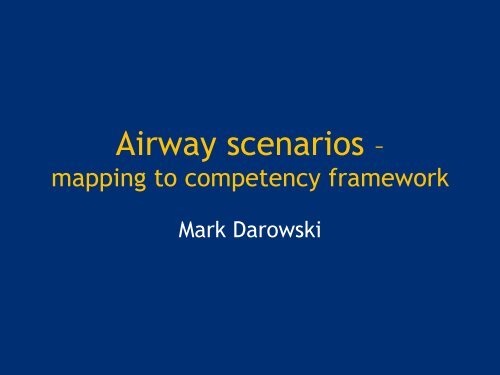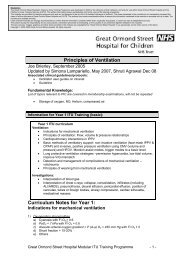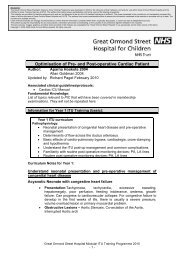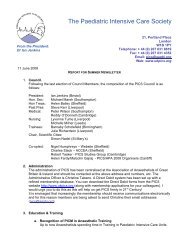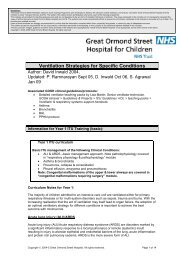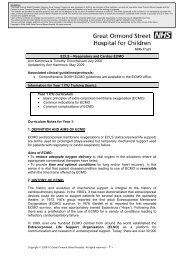Mapping airway scenarios - PICS
Mapping airway scenarios - PICS
Mapping airway scenarios - PICS
Create successful ePaper yourself
Turn your PDF publications into a flip-book with our unique Google optimized e-Paper software.
Airway <strong>scenarios</strong> –<br />
mapping to competency framework<br />
Mark Darowski
Scenario 1<br />
Dont touch the <strong>airway</strong><br />
History<br />
Child with known <strong>airway</strong> problem<br />
Presents obtunded and desaturating with<br />
apnoeas/bradypnea<br />
Adequate <strong>airway</strong> management + B&M<br />
ventilation maintains oxygenation.<br />
Actions<br />
Assessment<br />
Call for help<br />
Correct <strong>airway</strong> management, BMV<br />
Re-assessment<br />
Preparation for intubation<br />
Wait for assistance.
Scenario 2<br />
The straightforward case<br />
History<br />
Previously well child<br />
1 week fever, increasing respiratory<br />
distress. Confused<br />
Tachycardia, tachypnoea, SpO2 85%<br />
in high flow O2. Mod slow CRT,<br />
Mild hypotension, agitated and<br />
confused,<br />
Actions<br />
Assessment<br />
Call for help<br />
ABC, monitoring, venous access<br />
Assemble equipment, help and drugs<br />
Preoxygenate<br />
Perform RSI<br />
Post intubation management
Scenario 3<br />
The shocked child<br />
History<br />
Severe shock. Confused, A&B ok<br />
60ml/kg, Tachycardia, Hypotension, long<br />
CRT<br />
SpO2 92%<br />
Actions<br />
Assess A&B etc<br />
Continue fluid resus<br />
Start inotropes continue fluids<br />
Prepare drugs, equipment<br />
Cardiac arrest<br />
Needs CPR and adrenaline
Scenario 4<br />
The Head injury<br />
History<br />
Child knocked off bike<br />
GCS 10 at scene,<br />
A&B OK<br />
Fracture Tib and Fib<br />
Brought in by ambulance<br />
PICU trainee called to A&E<br />
Actions<br />
Assessment A+C spine, breathing<br />
Monitoring<br />
Circulation<br />
Primary survey<br />
Help<br />
Appropriate choice of drugs<br />
RSI<br />
Ongoing management
The failed intubation<br />
History<br />
Epiglottitis intubated and ventilated on<br />
unit<br />
Accidental extubation<br />
BG and mask ventilation impossible<br />
Unable to re-intubate<br />
LMA attempted – unsuccessful<br />
Cricothyroid puncture<br />
Actions<br />
Observes adequacy of ventilation and<br />
oxygenation<br />
Calls for help<br />
Attempts bag and mask ventilation<br />
Re-assess A,B,C<br />
Attempts failed intubation<br />
Follows failed intubation algorithm<br />
Institutes CPR if necessary
The accidental extubation on PICU<br />
History<br />
Child ventilated for respiratory failure<br />
Actions<br />
Assessment<br />
Sedation light<br />
Allows attempt at self ventilation<br />
Self-extubation<br />
Control of <strong>airway</strong> and breathing<br />
Desaturates when attempted to breathe<br />
Assess circulation and sedation status<br />
B&M ventilation improves situation but<br />
Sp02
The mapping process<br />
1. Cut & paste into spreadsheet<br />
2. Airway statements in 6<br />
domains<br />
1. Resus and stabilisation<br />
2. Organ system support<br />
3. Monitoring<br />
4. Use of equipment<br />
5. Specific circumstances<br />
1. Anaesthesia, analgesia and <strong>airway</strong><br />
management<br />
2. Trauma and Burns<br />
6. Professionalism<br />
3. 4 elements<br />
1. Knowledge<br />
2. Skills<br />
3. Attitude & behaviour<br />
4. Workplace training objectives
The mapping process<br />
1. 120 statements<br />
2. Numbered 1 - 120<br />
3. Grouped into domains
The mapping process
The mapping process<br />
• Each statement assigned to one of 7 phases in the intubation<br />
process.<br />
1. Communication, leadership and teamwork<br />
2. Assessment of patient<br />
3. BMV LMA<br />
4. Intubation<br />
5. Equipment<br />
6. Drugs<br />
7. Failed intubation
The mapping process
The mapping process<br />
• Sorted by phase<br />
• Duplicates and synonyms removed<br />
• Each statement mapped back to original<br />
numbers
The mapping process
The mapping process<br />
Each of 79 statements cross referenced to each of 6 <strong>scenarios</strong>.
The mapping process<br />
• Results<br />
– Scenarios included between 58 and 68<br />
statements<br />
– 4 statements not included in any scenario<br />
• Understands importance of pre-operative assessment<br />
• Nasotracheal intubation<br />
• Management of and complications associated with tracheostomy<br />
tubes<br />
• Recognition and management of anaphylactic and anyphalactoid<br />
reactions<br />
– 1 missing<br />
• Recognition and management of pneumothorax
Conclusions<br />
1. Scenarios can be mapped to competency framework<br />
2. The original 6 meet most of the requirements<br />
3. Some important gaps remain (nasotracheal intubation,<br />
pneumothorax, anaphylaxis)<br />
4. Not feasible to teach/practice/test/feedback all areas<br />
of competency framework in every scenario<br />
5. Considerable overlap with other areas
Conclusions<br />
“Suicide is painless”<br />
MASH circa 1970


